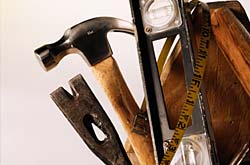The Hideous Houdini: Disappearance of the Middle-Class Home Improvement
See if We Have Top-Rated
Home Professionals in Your Area

The disappearance of the middle-class has become a dominant economic trend over the past decade to the point of becoming a truism. Harry Houdini himself couldn't perform a magic trick of this scale, and with the disappearance of the middle-class so goes much of the middle-class or mid-tier home improvement projects. Far from completely vanishing, you can still generally find home improvement companies that focus on kitchen and bath remodels and other home improvements using expedited timelines, journeyman subcontractors, and generic materials. At the same time, statistics show that high-end projects continue to consume a huge amount of total home improvement expenditures, while the slowing economy and housing market are driving a recent upsurge in basic home maintenance and upkeep.
Playing to the Audience: Middle-Class Homeowners in America
Ethically, it must be noted that the disappearance of the middle-class is a phenomenon that appears almost exclusively in the industrialized nations of the world—in many third-world countries, the middle-class never existed in the first place. In 2006, The World Institute for Development Economics Research completed what is arguably the most comprehensive study ever conducted on personal wealth. This study found that "the richest 1 percent of adults alone owned 40 percent of global assets in the year 2000, and that the richest 10 percent of adults accounted for 85 percent of the world total."
When discussing the trends of middle-class home improvements in America, one way of looking at the big picture is to look at the respective trends of homeowner income vs. home improvement expenditures. Looking at data from 1995 to 2005, provided by the Joint Center for Housing Studies of Harvard University, we see that while the percent of homeowners earning between $40,000-$120,000 (in 2005 dollars) increased from 47.4 percent to 51.1 percent, total expenditures for this group over the same time period, actually decreased from 52.2 percent to 47.9 percent. This means that the middle-class homeowner isn't disappearing, he or she just isn't spending as much money as they used to.
Moreover, while individual middle-class homeowners aren't disappearing, their habitat has been in decline for decades. In 2006, the Brookings Institute reported that, according to decennial consensus data from the 100 largest metropolitan areas "Middle-income neighborhoods as a proportion of all metropolitan neighborhoods declined from 58 percent in 1970 to 41 percent in 2000."
Looking into the Crystal Ball
The immediate future of the home improvement industry should reinforce the lower-end projects of the industry. The early and middle part of this decade saw the explosion of high-end, luxury home remodels, which accounted for an incredible one out of every three home improvement dollars in 2005, according to the Joint Center for Housing Studies of Harvard University. Today's high interest rates, stagnant pace of house appreciation, and, most recently, the inability to get financing for home remodels will surely cause a short-term dip in the percentage of these high-end remodels and a spike in the percentage of necessary home maintenance projects. That said, wealthy homeowners aren't going away anytime soon, and the long-term outlook remains good—the JCHS points out that by the middle of the next decade the Echo Boomers (the Baby Boomer's offspring) are poised to hit their peak spending years.
The Irony of this Vanishing Act and What it Means for You
In the short-term, however, this may be the ideal time to talk to any number of home improvement or remodeling contractors, especially if you have any liquid assets. Why? Many of the small businesses hit hardest by the credit crunch are home improvement contractors. Many of these contractors offer their own financing programs backed by their own credit with lending institutions?exactly the type of funds that are drying up with the current financial crisis. If you have the savings or a credit limit that will allow you to pay a contractor immediately upon the completion of the project, you may find that you can get a great quote from a business trying to simply stay afloat, until the credit markets rebound.
Conventional wisdom when choosing a home improvement professional is to get multiple estimates from contractors and to be wary of both the lowest and highest bids, especially when there's a big difference. At the same time, more and more contractors are specializing their services, looking to carve out a niche for homeowners who have either the finances to complete high-end home remodels and additions or who must complete their remodels and improvements on a shoe-string budget. The tension in the marketplace here is obvious. In the end, the conventional wisdom of choosing home improvement contractors will probably remain intact; it may just get harder to find contractors who offer value-oriented remodels of quality work and materials for reasonable prices.
More Tips & Advice For Your Home
- Related Articles
- Recent Articles

